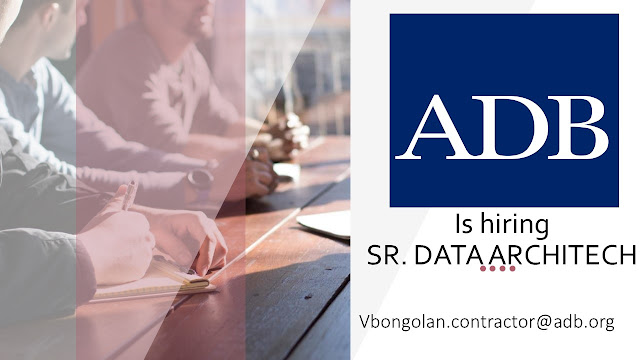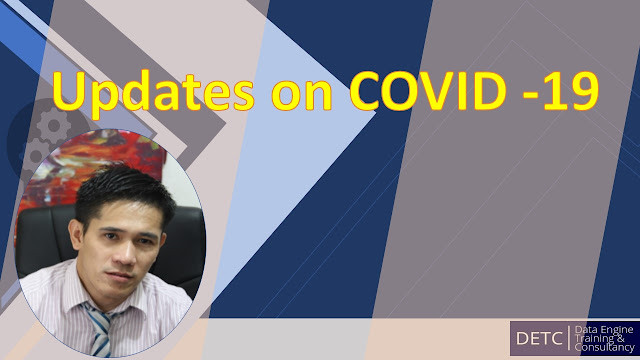Asian Development Bank (ADB) is hiring
(Note: I am not the Hiring Manager and I have no connection and contact to the department where the successful candidate will be assigned. I am just helping the agency who are one of the vendor of ADB in terms of resources).
JOB PURPOSE:
The Senior Data Architect is a senior member of the IT Enterprise Data
Management team and is tasked with oversighting the implementation of a Bank’s Enterprise Data Management Platform. This includes the evolution of the data hub design, development,
administration and maintenance of an optimal Data Fabric (data integration,
ingestion, Operational Data Store, Data Lake, DataMarts, Operational and
analytical Self-Services, Data Visualization tools).
The member must possess a broad and deep understanding of digital
capabilities in the data space, must have a strong grasp of data
visualization, curiosity and desire to collaborate with constructing the
vision and roadmap to build a Data Fabric
which is business user-centric through
the implementation of cutting-edge tools, technologies, enhanced data, and
highly integrated systems and processes
a)
Provide consulting support on
all data-related solutions (program design, report design, data feed design,
data aggregation, etc.).
b)
Collaborate with the technology
team to maintain and enhance the enterprise data management infrastructure
and technology strategy including governance, data storage, security and,
backup and recovery
a)
Design, manage the end-to-end
data pipelines, from the acquisition, orchestration, processing and the data
access across the Data Fabric
b)
Integrate disparate data
sources, structured and unstructured data into the data platform
c)
Collaborate on managing the
Metadata repository and documentation
d)
Identify, assess, and document
business requirements for data and advise on options, risks, and cost versus
benefits
e)
Collaborate with internal teams
to understand, translate and capture the requirements for conceptual and
logical data models, interface specifications to maximize the value and
performance of the data assets
f)
Establish data lineage across
data movement and ensure that the data is captured, stored, accessed, and
distributed accurately, consistently, and optimally
g)
Create and maintain appropriate
metadata for data architecture related artifacts including data lineage
h)
Help with establishing and
sustaining optimal data governance framework
i)
Responsible for building real
time data streams, Ingest data from heterogeneous data sources and publish
them as enterprise business events
j)
Unify the work between data
modeling and data acquisition, work on security and compliance data
architecture and help to set the standards and best practices
a)
Create data models and business
views that present data in a user-friendly schema, scale the data model and
enable self-serve analytics
b)
Collect data and use it to help
business stakeholders to make better business decisions
c)
Participate in the definition
of the Data Catalog, Data Services, APIs,
|
3. EXPECTED RESULTS:
Assigned
Responsibilities
·
Work with large amounts of
data: facts, figures, and number crunching, the member need to see through
the data and analyze it to find conclusion
·
Participate in presenting
findings, or translating the data into an understandable document, the member
will need to write and speak clearly, easily communicating complex ideas
·
Liaise with different
departments in our organization to follow up on any challenges or
discrepancies within the data
·
Act as the data expert, leading
the way in data discovery, both proactively and by request, to identify key
insights and trends to help drive strategic recommendations
·
Perform data abstraction,
cleansing, validation, modeling, interpretation and reporting.
·
Take data, understand it,
process it, extract value from it, and communicate it visually / verbally to
team members and key stakeholders (Business and IT) throughout the
organization
·
Work with the Enterprise Data
Management Lead and the project manager to document the project’s vision and
the project’s scope.
·
Work closely with developers
and a variety of end users to ensure technical compatibility and user
satisfaction.
·
Define quality attributes,
external interfaces, constraints, and other nonfunctional requirements.
·
Represent requirements using
alternative views, such as analysis models (diagrams), prototypes, or
scenarios, where appropriate and propose new solution features and updates
where appropriate.
·
Lead requirements analysis and
verification, ensuring that requirement statements are complete, consistent,
concise, comprehensible, traceable, feasible, unambiguous, and verifiable,
and that they conform to standards.
·
Participate in requirements
prioritization.
·
Participate in peer reviews and
inspections of requirements documents. Participate in peer reviews of work
products derived from requirements specifications to ensure that the
requirements were interpreted correctly.
·
Manage requirements
traceability information and track requirements status throughout the
project.
·
Manage changes to baselined
requirements through effective application of change control processes and
tools.
·
Work closely with developers
and a variety of end users to ensure technical compatibility and user
satisfaction.
·
Actively Participate in the
implementation of the new Data Fabric.
·
Implement ways to reuse
requirements across projects.
·
Identify ways to assist project
management in project planning through requirements development and analysis.
Key Deliverables
·
Control of requirements creep
attributable to missed requirements and leakage of “unofficial” requirements
into the project.
·
Satisfying or exceeding
requirements development schedules, resource constraints, and quality goals
·
Coordinate, Review and validate vendor resources
expected work is delivered and of quality
·
Clarify requirements with vendor resources and ensures
the same standards, processes, procedures on planning, execution are met as a
minimum
·
Work with project team members to ensure a successful
outcome for the project.
·
Architecture design artifact
detailing every component, data producers and data consumers of the new Data
Fabric
·
Requirements Definition Report
(RDR) and Solution Model Specification (SMS) project documentation
·
Review and validation of Data
modeling involved in the Data Platform
·
Artifacts of the Data Services
generated from the Data Fabric
·
Regular presentations with
supporting documents to business and IT stakeholders
·
Participation in the
development of the Center of Excellent on Enterprise Data Management
|
4. KEY
RELATIONSHIPS
|
|
a. Supervisor
Director and/or designated Professional Staff.
|
Work planning,
feedback, personal development, results
|
b. Internal
Clients
|
Provide analytical,
technical, and administrative support on project management and budget
related matters, systems enhancement and other special initiatives.
|
c. External
Clients
|
Coordinate with
other multilateral organizations to collect and compile data for organization
and business processes.
Supervises,
monitors, and coordinates with contractors and vendors to ensure that
equipment and services provided for the IT projects are within OIST
standards.
|
5. Education
Requirements:
Minimum of a Bachelor degree in Computer Science or related discipline
|
6. Relevant
Experience and Other Requirements:
· At least five (5)
years’ experience in a senior system analyst role, two (2) of which should be
working with senior users;
· Must have extensive experience using Microsoft products (Word, Excel,
Powerpoint, Visio, Project) for professional documentation
· Must have experience using UML to document system design
· Must be conversant
with systems development lifecycle principles
· Must be able to
relate to large information-based organizations and comfortable dealing with
senior executives from a variety of cultures
· Must have excellent
oral and written communication skills in English
· Must have
experience of Eclipse IDE, Struts framework, and Java programming language
· Familiarity with
Oracle relational databases and multi-tiered application concepts
· Extensive knowledge
of system development life cycle (SDLC) and utilization in system development
projects
· Well-developed
knowledge and understanding of relevant business administration, operational
policies relevant work program and concepts, procedures and practices
·
Proven ability to conduct independent research by
analyzing relationships among several parts of a problem or situation;
breaking down a complex task into manageable parts in a systematic way,
recognizing several likely causes of events, or several consequences of
actions and generally anticipate obstacles and thinks ahead about next steps
|




Comments
Post a Comment